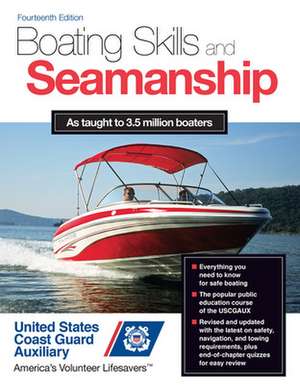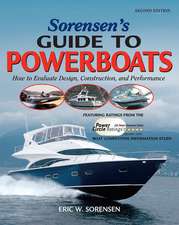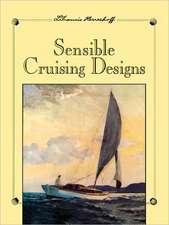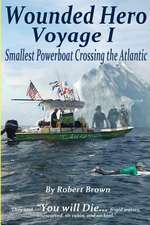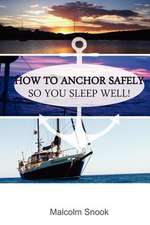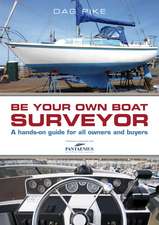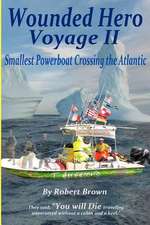Boating Skills and Seamanship, 14th Edition
Autor N/A U.S. Coast Guard Auxiliary Assoc., Inc.en Limba Engleză Paperback – 16 iul 2013
Learn the essentials of seamanship from one of the world's premier boating organizations
Developed and refined through 40 years of Coast Guard Auxiliary training courses, Boating Skills and Seamanship is your perfect introduction to recreational boating's fundamentals. Great for beginning and intermediate powerboaters alike, it offers you the basics of choosing, equipping, and handling a small to midsize powerboat.This updated edition of the Coast Guard Auxiliary'sclassic boating skills manual will answer all yourquestions on:
- Selecting the right boat--whether a 10-foot skiff or a 35-foot cruiser
- Essential equipment, both required and recommended
- The latest electronic navigation
- Personal Locator Beacons (PLBs) and private communication services, e.g., SPOT devices and others
- Stability and safe loading
- Boat handling and seamanship on coastal and inland waters
- Trailering a boat
- Navigation and the rules of the nautical road
- And much more!
Preț: 217.69 lei
Nou
Puncte Express: 327
Preț estimativ în valută:
41.67€ • 42.94$ • 35.18£
41.67€ • 42.94$ • 35.18£
Carte disponibilă
Livrare economică 11-25 februarie
Preluare comenzi: 021 569.72.76
Specificații
ISBN-13: 9780071829328
ISBN-10: 0071829326
Pagini: 416
Dimensiuni: 218 x 277 x 17 mm
Greutate: 0.84 kg
Ediția:New.
Editura: McGraw Hill Education
Colecția International Marine/Ragged Mountain Press
Locul publicării:United States
ISBN-10: 0071829326
Pagini: 416
Dimensiuni: 218 x 277 x 17 mm
Greutate: 0.84 kg
Ediția:New.
Editura: McGraw Hill Education
Colecția International Marine/Ragged Mountain Press
Locul publicării:United States
Cuprins
Introduction
Part One: Basic Skills and Seamanship
Chapter 1 Which Boat is For You?
Boaters’ Language
Types of Boats
Types of Propulsion
Hull Design
Sailboats
Uses of Boats
Boatbuilding Materials
Your Intended Use
Marine Surveyors
Buying a Boat
Ways to Learn More
Practice Questions
Chapter 2 Equipment for Your Boat
Requirements for Your Boat
Fire Prevention and Detection
Your Boat’s Equipment
Legal Considerations
Ways to Learn More
Practice Questions
Chapter 3 Trailering Your Boat
Legal Considerations
Practical Considerations
The Towing Vehicle
Trailer Hitches
Balancing the Load
Handling Your Trailer
Predeparture Checks
Preparing to Launch
Launching
Retrieving
Storing Your Boat and Trailer
Theft Prevention
Aquatic Nuisance Species
Float Plan
Ways to Learn More
Practice Questions
Chapter 4 Handling Your Boat
Leave with a Full Fuel Tank
Fueling Your Boat
Your Boat’s Propeller
Steering
Twin Screws
Outboard and Stern-Drive Installation and Tilt Adjustment
Jet Drives
Loading Your Boat
Getting Started
Man Overboard
Docking
Mooring to a Permanent Anchor
Anchoring
Towing a Skier
Heavy Weather
Impaired Visibility
Narrow Inlets
Small Boat Safety
Running Aground
Environmental Concerns
Ways to Learn More
Practice Questions
Chapter 5 Your “Highway” Signs
Buoyage Systems
Waterway Marks
How Waterways Are Marked
Light Characteristics
Chart Symbols
Light Structures
Lights on Bridges
Electronic Aids to Navigation
Navigation Publications
Ways to Learn More
Practice Questions
Chapter 6 The Rules of the Nautical Road
Two Sets of Rules
To Whom Do the Rules Apply?
Vessel Definitions
The General Responsibility Rule
General Considerations
Conduct in Narrow Channels
Traffic Separation Schemes
Stand-On or Give-Way?
Rules for Special Vessels
Risk of Collision
Bend Signals
Restricted Visibility
Vessel Lights and Shapes
Distress Signals
Homeland Security Measures
Courtesy and Safety
Drawbridges
Penalties
Ways to Learn More
Practice Questions
Chapter 7 Inland Boating
Inland Waters
Inland Navigation
Inland Seamanship
River Currents
Maintaining Inland Waterways
Dams
Locks
River Charts
Commercial Traffic
Before You Go
Ways to Learn More
Practice Questions
Chapter 8 Boating Safety
Small Boat Safety
Personal Watercraft
Water Risks
Powerboats and Sailboats
Carbon Monoxide Poisoning
Weather
Ways to Learn More
Practice Questions
Part Two: More Boating Skills
Chapter 9 Introduction to Navigation
Nautical Charts
Ship’s Compass
Fixing Your Position
Sources of Compass Error
Correcting a Compass Reading
Finding Your Position
Speed-Time-Distance
Dead Reckoning
Tides
Electronic Navigation
GPS Operation
Practice Your Art
A Further Invitation
Ways to Learn More
Practice Questions
Chapter 10 Powering Your Boat
Types of Marine Engines
Selecting a Propeller
Induction Systems
Ignition Systems
Flame Arresters
Cooling Systems
Gasoline Considerations
Batteries
Maintenance
Winterizing Your Boat
Spring Fitting Out
Troubleshooting
Ways to Learn More
Practice Questions
Chapter 11 Lines and Knots for Your Boat
Line or Rope?
Rope Materials
Rope Construction
Measuring Rope
Care of Rope
Making Up a Line
Knots, Bends, and Hitches
Splices
Securing Lines
Lead Lines
Dipping the Eye
Ways to Learn More
Practice Questions
Chapter 12 Weather and Boating
Weather Information
Wind and Boating
Understanding Weather
Nonfrontal Weather
The Go, No-Go Decision
Ways to Learn More
Practice Questions
Chapter 13 Your Boat’s Radio
Communications on the Water
Functions of Radiotelephones
Licenses
Selecting Your VHF-FM Radio
Installation
Operating Your VHF-FM
Copies of the Rules
Calling Another Station
Procedure Words
Phonetic Alphabet
Routine Radio Check
Distress, Urgency, and Safety Calls
Crew Training
Ways to Learn More
Practice Questions
Appendices
Appendix A: Your Responsibilities as a Boat Operator
Appendix B: Float Plan Form and Boating Emergency Guide
Appendix C: Boating Accident Report Form
Appendix D: Digital Selective Calling (DSC) Radio Fact Sheet and MMSI Registration Form
Appendix E: Metric Conversion Tables
Appendix F: Vessel Safety Check
Appendix G: Join the Coast Guard Auxiliary
Appendix H: Become an Associate Member
Appendix I: Preventive Boat Maintenance Checklist
Answer Key
Glossary
Index
Part One: Basic Skills and Seamanship
Chapter 1 Which Boat is For You?
Boaters’ Language
Types of Boats
Types of Propulsion
Hull Design
Sailboats
Uses of Boats
Boatbuilding Materials
Your Intended Use
Marine Surveyors
Buying a Boat
Ways to Learn More
Practice Questions
Chapter 2 Equipment for Your Boat
Requirements for Your Boat
Fire Prevention and Detection
Your Boat’s Equipment
Legal Considerations
Ways to Learn More
Practice Questions
Chapter 3 Trailering Your Boat
Legal Considerations
Practical Considerations
The Towing Vehicle
Trailer Hitches
Balancing the Load
Handling Your Trailer
Predeparture Checks
Preparing to Launch
Launching
Retrieving
Storing Your Boat and Trailer
Theft Prevention
Aquatic Nuisance Species
Float Plan
Ways to Learn More
Practice Questions
Chapter 4 Handling Your Boat
Leave with a Full Fuel Tank
Fueling Your Boat
Your Boat’s Propeller
Steering
Twin Screws
Outboard and Stern-Drive Installation and Tilt Adjustment
Jet Drives
Loading Your Boat
Getting Started
Man Overboard
Docking
Mooring to a Permanent Anchor
Anchoring
Towing a Skier
Heavy Weather
Impaired Visibility
Narrow Inlets
Small Boat Safety
Running Aground
Environmental Concerns
Ways to Learn More
Practice Questions
Chapter 5 Your “Highway” Signs
Buoyage Systems
Waterway Marks
How Waterways Are Marked
Light Characteristics
Chart Symbols
Light Structures
Lights on Bridges
Electronic Aids to Navigation
Navigation Publications
Ways to Learn More
Practice Questions
Chapter 6 The Rules of the Nautical Road
Two Sets of Rules
To Whom Do the Rules Apply?
Vessel Definitions
The General Responsibility Rule
General Considerations
Conduct in Narrow Channels
Traffic Separation Schemes
Stand-On or Give-Way?
Rules for Special Vessels
Risk of Collision
Bend Signals
Restricted Visibility
Vessel Lights and Shapes
Distress Signals
Homeland Security Measures
Courtesy and Safety
Drawbridges
Penalties
Ways to Learn More
Practice Questions
Chapter 7 Inland Boating
Inland Waters
Inland Navigation
Inland Seamanship
River Currents
Maintaining Inland Waterways
Dams
Locks
River Charts
Commercial Traffic
Before You Go
Ways to Learn More
Practice Questions
Chapter 8 Boating Safety
Small Boat Safety
Personal Watercraft
Water Risks
Powerboats and Sailboats
Carbon Monoxide Poisoning
Weather
Ways to Learn More
Practice Questions
Part Two: More Boating Skills
Chapter 9 Introduction to Navigation
Nautical Charts
Ship’s Compass
Fixing Your Position
Sources of Compass Error
Correcting a Compass Reading
Finding Your Position
Speed-Time-Distance
Dead Reckoning
Tides
Electronic Navigation
GPS Operation
Practice Your Art
A Further Invitation
Ways to Learn More
Practice Questions
Chapter 10 Powering Your Boat
Types of Marine Engines
Selecting a Propeller
Induction Systems
Ignition Systems
Flame Arresters
Cooling Systems
Gasoline Considerations
Batteries
Maintenance
Winterizing Your Boat
Spring Fitting Out
Troubleshooting
Ways to Learn More
Practice Questions
Chapter 11 Lines and Knots for Your Boat
Line or Rope?
Rope Materials
Rope Construction
Measuring Rope
Care of Rope
Making Up a Line
Knots, Bends, and Hitches
Splices
Securing Lines
Lead Lines
Dipping the Eye
Ways to Learn More
Practice Questions
Chapter 12 Weather and Boating
Weather Information
Wind and Boating
Understanding Weather
Nonfrontal Weather
The Go, No-Go Decision
Ways to Learn More
Practice Questions
Chapter 13 Your Boat’s Radio
Communications on the Water
Functions of Radiotelephones
Licenses
Selecting Your VHF-FM Radio
Installation
Operating Your VHF-FM
Copies of the Rules
Calling Another Station
Procedure Words
Phonetic Alphabet
Routine Radio Check
Distress, Urgency, and Safety Calls
Crew Training
Ways to Learn More
Practice Questions
Appendices
Appendix A: Your Responsibilities as a Boat Operator
Appendix B: Float Plan Form and Boating Emergency Guide
Appendix C: Boating Accident Report Form
Appendix D: Digital Selective Calling (DSC) Radio Fact Sheet and MMSI Registration Form
Appendix E: Metric Conversion Tables
Appendix F: Vessel Safety Check
Appendix G: Join the Coast Guard Auxiliary
Appendix H: Become an Associate Member
Appendix I: Preventive Boat Maintenance Checklist
Answer Key
Glossary
Index
